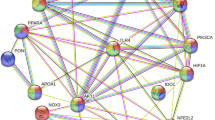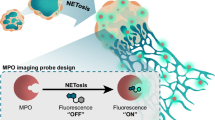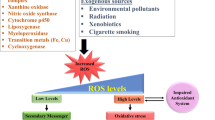Abstract
High-redox-potential reactive oxygen species and reactive nitrogen species (ROS/RNS), generated by NADPH oxidase-2 (NOX2), myeloperoxidase (MPO) and related enzymes, are key effector molecules of innate immunity. High-redox-potential radicals are difficult to distinguish by imaging from less potent ROS/RNS functioning as background biological signaling molecules. Here we present 4-[18F]fluoro-1-naphthol ([18F]4FN), a redox-tuned radiopharmaceutical that selectively binds proteins and cells when oxidized by products of human MPO plus H2O2, but not H2O2 alone, and can be detected using positron emission tomography (PET). Activating HL-60 neutrophil-like human cells with phorbol ester (PMA) caused [18F]4FN retention five-fold over unstimulated cells. An MPO-specific inhibitor (4-ABAH) blocked cellular retention by more than 95%. [18F]4FN PET/CT imaging discriminated inflammatory foci in vivo in three murine models of activated innate immunity: endotoxin-induced toxic shock, PMA-induced contact dermatitis and lipopolysaccharide-induced ankle arthritis. 4-ABAH and Cybb−/− (Nox2−/−) gene deletion strongly abrogated [18F]4FN retention in vivo. Thus, [18F]4FN shows promise as a robust reporter of innate immunity activation by PET/CT.
This is a preview of subscription content, access via your institution
Access options
Access Nature and 54 other Nature Portfolio journals
Get Nature+, our best-value online-access subscription
$32.99 / 30 days
cancel any time
Subscribe to this journal
Receive 12 print issues and online access
$259.00 per year
only $21.58 per issue
Buy this article
- Purchase on SpringerLink
- Instant access to full article PDF
Prices may be subject to local taxes which are calculated during checkout





Similar content being viewed by others
Data availability
Source data are provided with this paper. Any remaining raw data will be available from the corresponding author upon reasonable request. Source data are provided with this paper.
References
Zindel, J. & Kubes, P. DAMPs, PAMPs, and LAMPs in immunity and sterile inflammation. Annu. Rev. Pathol. 15, 493–518 (2020).
Schroder, K. & Tschopp, J. The inflammasomes. Cell 140, 821–832 (2010).
Marquez, L. A. & Dunford, H. B. Kinetics of oxidation of tyrosine and dityrosine by myeloperoxidase compounds I and II. Implications for lipoprotein peroxidation studies. J. Biol. Chem. 270, 30434–30440 (1995).
Nishinaka, Y., Arai, T., Adachi, S., Takaori-Kondo, A. & Yamashita, K. Singlet oxygen is essential for neutrophil extracellular trap formation. Biochem. Biophys. Res. Commun. 413, 75–79 (2011).
Spiller, K. L. et al. Differential gene expression in human, murine, and cell line-derived macrophages upon polarization. Exp. Cell. Res. 347, 1–13 (2016).
Montezano, A. C. & Touyz, R. M. Reactive oxygen species and endothelial function–role of nitric oxide synthase uncoupling and Nox family nicotinamide adenine dinucleotide phosphate oxidases. Basic Clin. Pharmacol. Toxicol. 110, 87–94 (2012).
Arasimowicz-Jelonek, M., Floryszak-Wieczorek, J., Abramowski, D. & Izbiańska, K. In: Nitric Oxide in Plants: Metabolism and Role in Stress Physiology (eds Khan, M. N., Mobin, M., Mohammad, F., & Corpas, F. J.) 165–184 (Springer International Publishing, 2014).
Cronin, S. J. F., Woolf, C. J., Weiss, G. & Penninger, J. M. The role of iron regulation in immunometabolism and immune-related disease. Front. Mol. Biosci. 6, 116 (2019).
Sharrock, J. & Sun, J. C. Innate immunological memory: from plants to animals. Curr. Opin. Immunol. 62, 69–78 (2020).
Zámocký, M. et al. Independent evolution of four heme peroxidase superfamilies. Arch. Biochem. Biophys. 574, 108–119 (2015).
Davies, M. J. Myeloperoxidase-derived oxidation: mechanisms of biological damage and its prevention. J. Clin. Biochem. Nutr. 48, 8–19 (2011).
Jelcic, M., Enyedi, B., Xavier, J. B. & Niethammer, P. Image-based measurement of H2O2 reaction-diffusion in wounded zebrafish larvae. Biophys. J. 112, 2011–2018 (2017).
Elias, J. M. A rapid, sensitive myeloperoxidase stain using 4-chloro-1-naphthol. Am. J. Clin. Pathol. 73, 797–799 (1980).
Eastmond, D. A., French, R. C., Ross, D. & Smith, M. T. Metabolic activation of 1-naphthol and phenol by a simple superoxide-generating system and human leukocytes. Chem. Biol. Interact. 63, 47–62 (1987).
Sreekanth, R., Prasanthkumar, K. P., Sunil Paul, M. M., Aravind, U. K. & Aravindakumar, C. T. Oxidation reactions of 1- and 2-naphthols: an experimental and theoretical study. J. Phys. Chem. A 117, 11261–11270 (2013).
Islam, A., Lee, S.-E. & Jang-Eok, K. Enhanced enzymatic transformation of 1-naphthol in the presence of catechol by peroxidase. J. Korean Soc. Appl. Biol. Chem. 57, 209–215 (2014).
Tredwell, M. et al. A general copper-mediated nucleophilic 18F fluorination of arenes. Angew. Chem. Int. Ed. Engl. 53, 7751–7755 (2014).
Daiber, A. et al. Measurement of NAD(P)H oxidase-derived superoxide with the luminol analogue L-012. Free Radic. Biol. Med. 36, 101–111 (2004).
Xu, F., Koch, D. E., Kong, I. C., Hunter, R. P. & Bhandari, A. Peroxidase-mediated oxidative coupling of 1-naphthol: characterization of polymerization products. Water Res. 39, 2358–2368 (2005).
Seitz, P. M. et al. Development of a high-throughput cell-based assay for superoxide production in HL-60 cells. J. Biomol. Screen. 15, 388–397 (2010).
Augsburger, F. et al. Pharmacological characterization of the seven human NOX isoforms and their inhibitors. Redox Biol. 26, 101272 (2019).
Doi, K., Leelahavanichkul, A., Yuen, P. S. & Star, R. A. Animal models of sepsis and sepsis-induced kidney injury. J. Clin. Invest. 119, 2868–2878 (2009).
Cunningham, P. N., Wang, Y., Guo, R., He, G. & Quigg, R. J. Role of Toll-like receptor 4 in endotoxin-induced acute renal failure. J. Immunol. 172, 2629–2635 (2004).
Gross, S. et al. Bioluminescence imaging of myeloperoxidase activity in vivo. Nat. Med. 15, 455–461 (2009).
Hayeri, M. R., Ziai, P., Shehata, M. L., Teytelboym, O. M. & Huang, B. K. Soft-tissue infections and their imaging mimics: from cellulitis to necrotizing fasciitis. Radiographics 36, 1888–1910 (2016).
Galban, C. J. et al. Applications of molecular imaging. Prog. Mol. Biol. Transl. Sci. 95, 237–298 (2010).
Jones, H. A. et al. Dissociation between respiratory burst activity and deoxyglucose uptake in human neutrophil granulocytes: implications for interpretation of 18F-FDG PET images. J. Nucl. Med. 43, 652–657 (2002).
Bruno, J. G. & Kiel, J. L. Luminol and diazoluminomelanin as indicators of HL-60 cell differentiation. Vitr. Cell Dev. Biol. Anim. 29A, 737–741 (1993).
Locksley, R. M., Wilson, C. B. & Klebanoff, S. J. Increased respiratory burst in myeloperoxidase-deficient monocytes. Blood 62, 902–909 (1983).
Werry, E. L. et al. Recent developments in TSPO PET imaging as a biomarker of neuroinflammation in neurodegenerative disorders. Int. J. Mol. Sci. 20, 3161 (2019).
Shao, X. et al. Imaging of carrageenan-induced local inflammation and adjuvant-induced systemic arthritis with [11C]PBR28 PET. Nucl. Med. Biol. 40, 906–911 (2013).
Lee, Y., Park, Y., Nam, H., Lee, J. W. & Yu, S. W. Translocator protein (TSPO): the new story of the old protein in neuroinflammation. BMB Rep. 53, 20–27 (2020).
Zhang, L. et al. Recent developments on PET radiotracers for TSPO and their applications in neuroimaging. Acta Pharm. Sin. B 11, 373–393 (2021).
Colovic, M. et al. Non-invasive use of positron emission tomography to monitor diethyl maleate and radiation-induced changes in system xC− activity in breast cancer. Mol. Imaging Biol. 21, 1107–1116 (2019).
Yang, H. et al. 18F-5-fluoroaminosuberic acid as a potential tracer to gauge oxidative stress in breast cancer models. J. Nucl. Med. 58, 367–373 (2017).
Sivapackiam, J. et al. Galuminox: preclinical validation of a novel PET tracer for non-invasive imaging of oxidative stress in vivo. Redox Biol. 37, 101690 (2020).
Wu, J. et al. Feasibility study of PET dynamic imaging of [18F]DHMT for quantification of reactive oxygen species in the myocardium of large animals. J. Nucl. Cardiol. https://doi.org/10.1007/s12350-020-02184-3 (2020).
Wang, S. T. et al. Sensitivity of activatable reactive oxygen species probes by fluorescence spectroelectrochemistry. Analyst 138, 4363–4369 (2013).
Hou, C. et al. Development of a positron emission tomography radiotracer for imaging elevated levels of superoxide in neuroinflammation. ACS Chem. Neurosci. 9, 578–586 (2018).
Egami, H. et al. [18F]-Labeled dihydromethidine: positron emission tomography radiotracer for imaging of reactive oxygen species in intact brain. Org. Biomol. Chem. 18, 2387–2391 (2020).
Carroll, V. N. et al. [11C]Ascorbic and [11C]dehydroascorbic acid, an endogenous redox pair for sensing reactive oxygen species using positron emission tomography. Chem. Commun. (Camb.) 52, 4888–4890 (2016).
Wang, C. et al. An activatable PET imaging radioprobe is a dynamic reporter of myeloperoxidase activity in vivo. Proc. Natl Acad. Sci. USA 116, 11966–11971 (2019).
Halliwell, B. & Gutteridge, J. M. Biologically relevant metal ion-dependent hydroxyl radical generation. An update. FEBS Lett. 307, 108–112 (1992).
Bhattacharjee, S., Chatterjee, S., Jiang, J., Sinha, B. K. & Mason, R. P. Detection and imaging of the free radical DNA in cells–site-specific radical formation induced by Fenton chemistry and its repair in cellular DNA as seen by electron spin resonance, immuno-spin trapping and confocal microscopy. Nucleic Acids Res. 40, 5477–5486 (2012).
Leto, T. L. & Geiszt, M. Role of Nox family NADPH oxidases in host defense. Antioxid. Redox Signal. 8, 1549–1561 (2006).
Kamada, N. & Rogler, G. The innate immune system: a trigger for many chronic inflammatory intestinal diseases. Inflamm. Intest. Dis. 1, 70–77 (2016).
Tay, M. Z., Poh, C. M., Renia, L., MacAry, P. A. & Ng, L. F. P. The trinity of COVID-19: immunity, inflammation and intervention. Nat. Rev. Immunol. 20, 363–374 (2020).
Wood, P. M. The potential diagram for oxygen at pH 7. Biochem. J. 253, 287–289 (1988).
Kucera, J. Biofouling of polyamide membranes: fouling mechanisms, current mitigation and cleaning strategies, and future prospects. Membranes (Basel) 9, 111 (2019).
Koppenol, W. H., Moreno, J. J., Pryor, W. A., Ischiropoulos, H. & Beckman, J. S. Peroxynitrite, a cloaked oxidant formed by nitric oxide and superoxide. Chem. Res. Toxicol. 5, 834–842 (1992).
Arnhold, J., Furtmuller, P. G. & Obinger, C. Redox properties of myeloperoxidase. Redox Rep. 8, 179–186 (2003).
Koppenol, W. H., Stanbury, D. M. & Bounds, P. L. Electrode potentials of partially reduced oxygen species, from dioxygen to water. Free Radic. Biol. Med. 49, 317–322 (2010).
Das, T. N. & Neta, P. Reduction potentials of naphthoxyl and pyridoxyl radicals in aqueous solutions. J. Phys. Chem. A 102, 7081–7085 (1998).
Harvey, D. Standard reduction potentials by element. https://chem.libretexts.org/ (2021).
Koppenol, W. H. Thermodynamic considerations on the formation of reactive species from hypochlorite, superoxide and nitrogen monoxide. Could nitrosyl chloride be produced by neutrophils and macrophages? FEBS Lett. 347, 5–8 (1994).
Bartberger, M. D. et al. The reduction potential of nitric oxide (NO) and its importance to NO biochemistry. Proc. Natl Acad. Sci. USA 99, 10958–10963 (2002).
Halliwell, B., Clement, M. V. & Long, L. H. Hydrogen peroxide in the human body. FEBS Lett. 486, 10–13 (2000).
Trujillo, M., Alvarez, B. & Radi, R. One- and two-electron oxidation of thiols: mechanisms, kinetics and biological fates. Free Radic. Res. 50, 150–171 (2016).
Jensen, S. B., Nielsen, K. M., Mewis, D. & Kaufmann, J. Fast and simple one-step preparation of 68Ga citrate for routine clinical PET. Nucl. Med. Commun. 34, 806–812 (2013).
Acknowledgements
We acknowledge support from the Gerald Dewey Dodd, Jr. Endowed Distinguished Chair at The University of Texas MD Anderson Cancer Center and a Faculty UT STARs Award. We would like to thank the Small Animal Imaging Facility and the Science Park Research Histology, Pathology and Imaging Core at MD Anderson Cancer Center for animal imaging and histology, respectively, especially C. Kingsley and J. DeLacerda. Both core facilities obtain support from the National Cancer Institute Cancer Center Support Grant (P30 CA016672).
Author information
Authors and Affiliations
Contributions
Conceptualization: F.P., S.T.G. and D.P.W.; Methodology: F.P. and S.T.G.; Experimental performance: F.P., S.T.G., S.Q. and V.P.; Formal analysis: F.P., S.T.G., S.Q., V.P. and D.P.W.; Writing—original draft preparation: F.P., S.T.G. and D.P.W.; Writing—review and editing: F.P., S.T.G., S.Q., V.P. and D.P.W.; Funding acquisition: D.P.W. All authors have read and agreed to the published version of the manuscript.
Corresponding author
Ethics declarations
Competing interests
The University of Texas MD Anderson Cancer Center has filed a patent application on compounds and methods described in this report (S.T.G., F.P. and D.P.W., inventors). The remaining authors have no conflicts of interest.
Peer review
Peer review information
Nature Biotechnology thanks Delphine Chen, Xiaoyuan Chen and Kenneth Krohn for their contribution to the peer review of this work.
Additional information
Publisher’s note Springer Nature remains neutral with regard to jurisdictional claims in published maps and institutional affiliations.
Extended data
Extended Data Fig. 1 Chemical characterization.
1H NMR (compound 2), top; 13C NMR (compound 2), mid; HPLC analysis of [18F]4FN, bottom, A: QC of radioactive [18F]4FN (gamma trace). B: QC of radioactive [18F]4FN (UV trace at 254 nm). C: cold 4FN as reference compound. HPLC column: Bridge C18, 3.5 µm, 4.6×250 mm; Method: A-water (0.1% TFA), B-MeCN (0.1% TFA) B: 40% for 3 min, 40%→95% in 7 min, 95% for 1 min, flow 1 mL/min. NOTE the compressed scale of B to highlight the high purity of and molar activity of the compound.
Extended Data Fig. 2 PET image-based clearance and blood-to-brain ratios.
Individual PET image-based time-activity curves derived from heart (representing the blood pool) and brain VOIs.
Extended Data Fig. 3 [18F]4FN PET/CT in a model of mild contact dermatitis.
A) BALB/cN mice were treated with either PMA or vehicle and imaged 24 hr post treatment by PET/CT scanning at 1 hr post-injection (i.p.) of [18F]4FN. B) photograph 3 hr post [18F]4FN injection. C) BLI 10 min post luminol injection.
Extended Data Fig. 4 [18F]4FN PET/CT in a model of mild contact dermatitis.
A) In BALB/cN mice, 4-ABAH treatment mildly inhibited PMA-induced retention of [18F]4FN when compared to untreated animals. 2-way ANOVA with replication, test for interaction. B) 4-ABAH-induced inhibition appeared more evident when data were plotted as PMA/vehicle ratio showing a 50% reduction in PMA-induced retention (p = 0.1, one-tailed non-parametric t-test). C) In Mpo-/- mice (KO), any effect was below the limit of detection and appeared to be compensated by another ROS-producing mechanism. Data are presented as mean + /- SEM. Each point represents an individual animal.
Extended Data Fig. 5 Conservation of sequence across multiple species, but rodents underestimate MPO content and ROS burst broadly.
CYBB sequence of the NOX2 complex is conserved from yeast to plant to mouse to man; MPO sequence is conserved at the vertebrate level from frogs to mouse to man, but MPO content and ROS/RNS flux (as measured by PMA-induced chemiluminescence (CL activity) through these pathways) show significant interspecies variance (data from literature reports with human activity set to unity) (Surgery 126, 248-254 (1999); J. Immunol. Methods 115, 141-147 (1988); Comp Biochem Physiol B 75, 335-340 (1983); Blood 46, 913-919 (1975)).
Extended Data Fig. 6 Imaging of WT vs Nox2-/- (KO) mice confirmed that the KO mice had functionally impaired RONS production as validated by L-012 BLI imaging.
The right ears were treated with PMA as described and then imaged by [18F]4FN PET/CT. Mice were subsequently injected with L-012 i.p. (20 mg/kg) and imaged for bioluminescence (IVIS SPECTRUM, Perkin Elmer). Data are presented as mean + /- SEM. Each point represents an individual animal.
Supplementary information
Source data
Source Data Fig. 4c
Multi-scale Leica microscopy files for Fig. 4c
Rights and permissions
About this article
Cite this article
Pisaneschi, F., Gammon, S.T., Paolillo, V. et al. Imaging of innate immunity activation in vivo with a redox-tuned PET reporter. Nat Biotechnol 40, 965–973 (2022). https://doi.org/10.1038/s41587-021-01169-y
Received:
Accepted:
Published:
Issue date:
DOI: https://doi.org/10.1038/s41587-021-01169-y
This article is cited by
-
One-step screening of myeloperoxidase aptamer using porous PEG hydrogel
Advanced Composites and Hybrid Materials (2025)
-
Development of STING probes and visualization of STING in multiple tumor types
European Journal of Nuclear Medicine and Molecular Imaging (2025)
-
PET Imaging of Diabetes-Induced Alterations in Metabolism and Immune Activation
Molecular Imaging and Biology (2025)
-
Advances in PET imaging of oxidative stress: tracer innovation, mechanistic insight, and translational potential
European Journal of Nuclear Medicine and Molecular Imaging (2025)
-
A positron emission tomography tracer for the imaging of oxidative stress in the central nervous system
Nature Biomedical Engineering (2025)



